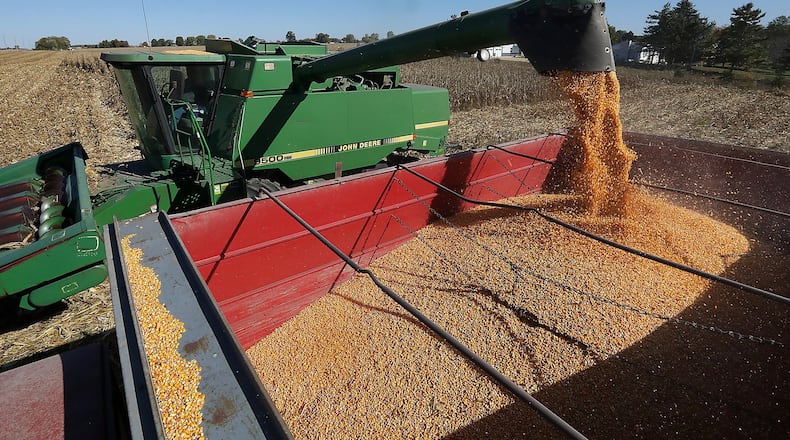Local farm income affects families throughout southwest Ohio and plays a role in the health of the Dayton area economy.
Government payouts are expected to make up about 17 percent of farmer’s net cash incomes this year — the highest in recent years — Katchova said. Those payouts include disaster relief money to make up for the floods that prevented farmers from planting in the spring and money from the Market Facilitation Program (MFP), which is designed to offset the trade war’s impact on crops and livestock.
Economists say Ohio farmers could see higher farm incomes this year than last because of the payments. Area growers say they are unsure that is true.
»BIZ BEAT: Average airfare at Dayton airport among top five most expensive
“Overall, farmers expect to have lower yields this year, particularly in Ohio, because of the amount of rainfall in the spring, which prevented or delayed planting. But it seems like their incomes, on average, are going to be fine,” Katchova said. “We can be cautiously optimistic right now. Farm incomes have stabilized. If anything, they’re slightly improving.”
Last year Ohio farmer’s reached record yields while growers in other states had terrible crops, said OSU agriculture economist Ben Brown. The forecast that calls for Ohio farmers to see more income this year also includes all crops, livestock and byproducts, Brown said, not just the corn and soybean crop being harvested now.
“Every farm is in a different situation. Last year we probably had some of the best crop we ever raised. So we’re coming off a very good year in ‘18, and ‘19 is going to be the opposite,” said Dave Baird, who operates a farm in Mad River Twp. “This is my 31st year of farming and I’ll just say this: Between the weather and government uncertainty, it’s been the most stressful year I’ve ever farmed.”
Area farmers reached this week said they don’t see how it’s possible they could make more money this year than last, even with the government payouts and insurance for farmers who weren’t able to get a crop in the ground last spring.
“If we don’t have the extra bushels, we’re not going to be able to sell them and the market is still depressed from the tariffs that we’re fighting…so I don’t think income’s going to up,” said Clark County farmer Brian Harbage.
In Darke County, Dean Thompson’s beans averaged in the mid-50 bushels per acre, a drop from the usual mid 60s. Yields throughout the county ranged between the mid-30s and mid-60s, he said.
The 180 to 190 bushels per acre Bob Suver started with when harvesting his Clark County crop quickly dropped in half in wetter portions of the same field, averaging 150 bushels per acre, 65 bushels per acre down from his high of 215, he said.
Other farmers like Baird, when faced with a choice to “mud in” the crops or not plant at all, chose to take insurance on some acres, which in the long run probably came out with about the same income as if he’d planted, Baird said.
“Insurance helps keep you going to the next year, that’s all it does. I’m not going to get rich on insurance, but it’s going to keep me from going backward,” Baird said.
The nearly 1.5 million Ohio acres covered by plant insurance this year is one reason average farm incomes could rise compared to last year, Brown said. Some of the farmers who used the insurance could make more money than if they’d planted.
»BIZ BEAT: Longaberger basket building to become boutique hotel
Market Facilitation payments also more than doubled this year to $10.7 billion, Katchova said.
So far only one of the MFP payments has been distributed, totaling half the expected payout. The other two payments are not guaranteed depending on how trade talks with China progress.
If Thompson gets all three payments this year, he said he’ll get about $8,000 more than last year, a 50 percent jump.
The split of corn to soybeans planted also impacted the higher payout, Brown said.
But the payments aren’t enough to get farmers back to where they need to be, said Butler County farmer Gail Lierer. Unless the trade war gets worked out farmers will continue to struggle because of the low prices, she said.
“Farming has got to be the job, the profession, with more variables than anything else because we’re at the mercy of everything whether its weather or cost or sales,” Thompson said. “We’re just at the mercy of too many other things to ever get a handhold on exactly what’s going to take place.”
FIVE FAST READS
• Popular Dayton sports complex makes a comeback following tornado
• Needmore Kroger closing comes at ‘vulnerable time’ following tornadoes
• Magic Castle making large investment in entertainment center
• Here’s what to expect with your home heating prices this winter
• Business email scams target paychecks, accounts for companies
By the numbers
1.5M : Ohio acres that went unplanted
$10.7B: Tariff aid expected this year
17: Percent of a farm’s net cash income from government payments
About the Author
